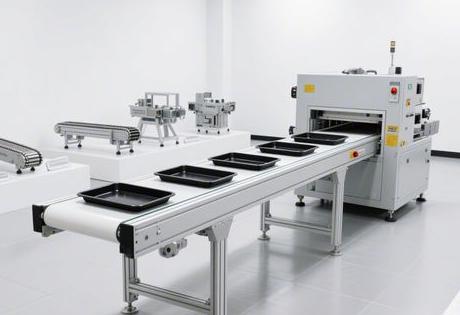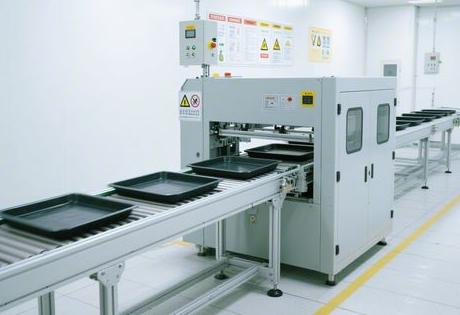###The key role of cornering mechanisms in automated production
In the electronics assembly plant, a double-deck speed chain conveyor line is running at a rate of20 metres per minuteThe pallets are transported. As the boards approach the end of the line, they are not returned directly to the line as in a traditional assembly line, but are moved through a set of precision90 Degree Turning MechanismIt turns smoothly and enters the lower return track perpendicular to it. This process requires no human intervention, and the boards on the tooling board are alwaysMaintain a fixed orientationThis is the basis for the precise assembly of the next process. Such a scenario is a typical application of the double-layer speed chain cornering technology in modern industrial automation.

Conventional single-layer multiplier chain lines require additional floor space for pallet return, whereas double-layer structures can be used for the return of pallets through thetop-down vertical layoutThe return track is placed underneath the working level, increasing the space utilisation by more than 50%. Especially in the electronics, home appliances and other industries, when the product needs to be in theCyclic assembly between multiple stationsThe corner mechanism becomes a "space joint" connecting parallel or perpendicularly arranged production lines, realisingSeamless commutation transfer of work plates.
The core structure and operating principle of the doubling chain cornering system
#####Precision synergy of mechanical structures
A complete cornering system consists of three core components:

- Jacking and panning mechanism: The carrier plate is driven by a cylinder to lift the workpiece off the speed chain rollers and away from the friction drive.
- rotating platformServomotor-driven precision gear set for precise steering of the work plate from 0 to 180 degrees (error ≤ 0.5°)
- Orbital docking systems: Width-adjustable guide rails to ensure precise alignment of the workpiece with the target conveyor line.
Taking the automotive motor assembly line as an example, when the work plate enters the corner station, the photoelectric sensor triggers the lifting action, lifting the work plate carrying 50kg workpiece by 10mm within 0.3 seconds, then the rotating platform completes the 90-degree steering in 1.5 seconds, and the urethane rollers on the guiding rails guide the work plate to slide into the vertical line, the whole process is controlled in the2 seconds or less..
#####Dynamical basis of the multiplicative chain
The efficient operation of the cornering system is made possible by the special features of the doubler chain.Differential Principle::
make a copy ofLet the chain speed be Vc, the diameter of the roller be d, and the diameter of the carrier wheel be D Then the work plate speed Vp = Vc × (1 + D/d) When D/d = 2, a 3-fold speed effect is formed (Vp = 3Vc)This structure allows the workpiece to be used in the straight section up to3x chain speedInstead, precise speed control is achieved by disengaging the chain in the corner section, which solves the contradiction between high-speed operation and precise positioning.
The innovative value of cornering mechanisms in spatial optimisation
#####A transformative breakthrough in floor plan layout
A real-world example from an appliance factory confirms its value:
- pre-conversionU-shaped single-layer production line, 62 metres long, covering an area of 380 square metres.
- after conversion: Double-storey right-angle layout, total length compressed to 38 metres and footprint reduced to 210m2 by 4 sets of corner machines.
- Space saving rate: 44.71 TP3T while increasing capacity by 221 TP3T (due to reduction in workpiece reflow time)
More notably, the cornering system makes theMulti-species mixed-line productionThis is possible. When two parallel production lines are producing different types of products, the dynamic scheduling of the tooling boards can be realised through the central corner hub. If line A fails to detect defective products, it can be immediately transferred to line B for repair, avoiding the "breakpoint" transfer of traditional production lines.
#####Key parameters for mechanical design
There are three main technical points that need to be controlled in order to achieve stable steering:
-
load adaptation
- Light duty (<30kg): Aluminium alloy rotating disc, response time 0.5 sec.
- Heavy duty (>100kg): equipped with steel crossed roller bearings, servo motor torque ≥50N-m
-
Precision control
- Repeat positioning accuracy: ±0.2mm
- Guide rail clearance: width of tooling plate + 3 mm (to prevent jamming)
- Levelling error: ≤0.3mm/m (laser calibration)
-
Safety Redundancy
- Dual limit switches (mechanical + photoelectric)
- Overload Current Protection Threshold: Rated 110%
- Emergency stop response: <0.2 seconds (cut off air and power)
Precise control strategies for cornering systems under special operating conditions
In PV module production lines, cornering mechanisms face special challenges - work plates need to carry1.8 metre long solar panelThe solution was the development of a 90-degree steering system with a positioning accuracy of ±1mm.Three-section telescopic guide::
- Automatically widens the guideway to 2200mm when it senses the approach of a pallet.
- Lateral auxiliary wheelsets to keep long parts balanced during jacking rotation
- Before docking to the target rail, the guide rail shrinks to a standard width of 1850mm
This dynamic adjustability allows the cornering system to be adapted to theProducts with different specificationsThe changeover time is only 3 minutes.
For clean rooms (e.g. LCD panel production), corner mechanisms increase the number ofParticle monitoring function. When the rotating platform is in action, the built-in sensor detects the number of particles above 0.5μm in real time and automatically initiates the ionic air cleaning process as soon as it exceeds the ISO class 4 standard (<3520 particles per cubic metre). This willIntegration of functional components with environmental controlsThe design represents a high-level evolutionary direction for cornering technology.
The intelligent future of cornering systems
#####Digital twin-driven predictive maintenance
Currently deployed in corner organisations by leading factoriesVibration-Temperature Composite SensorsThe digital twin is used to collect bearing status data every 10 milliseconds. This information is synchronised to the digital twin platform, where machine learning algorithms are used to predict faults:
- Ball bearing wear characteristics: increased vibration energy in the 500-800 Hz frequency band
- Gear mesh abnormality: Temperature gradient over 0.5°C/minute
Practical examples have shown that this technology has resulted in downtime for cornering mechanism failuresReduction of 67%.
#####A revolution in modular architecture
The new cornering system usesLego-style assembly design::
- Base module: 30/60/90 degree standard steering units available
- Expansion interface: support to add vision detection module, force feedback regulator
With this architecture, an electric vehicle company was able to reorganise its production line in just 48 hours to accommodate changes in the size of the tooling boards for the new model, saving about $10 million in traditional retrofit costs.$850,000.
Ask yourself the core question.
Q1:How to ensure the positioning accuracy when steering the work plate?
Three-stage control by "lift-rotate-fall": pneumatic lift off the chain to eliminate vibration; servo motor with encoder to achieve 0.1° angular resolution; guide rail V-groove and the work plate roller to form a self-aligning effect.
Q2: Does the double-storey structure make maintenance more difficult?
Instead, it reduces maintenance intensity - the lower return track is 1.2 metres from the ground, allowing engineers to stand and access it; the modular design reduces chain changeover time from 3 hours to 40 minutes; and the intelligent lubrication system automatically injects oil according to the mileage run.
Q3: Why not robotic grab steering?
Economic comparison shows that: the robot programme costs more than 150,000 yuan per point, while the average price of the cornering mechanism is 48,000 yuan; and the mechanical steering beat is as fast as 2 seconds / time, far more than the robot's average 8-second grasp and release cycle.













